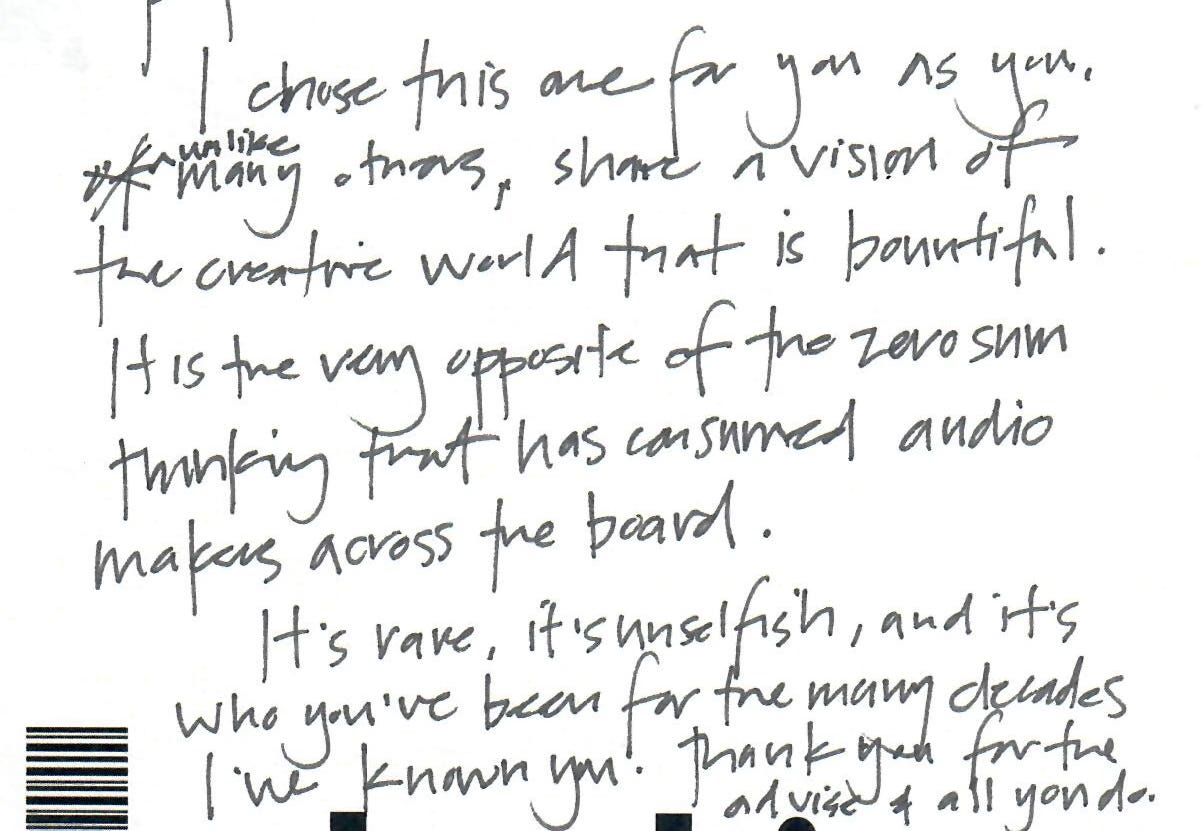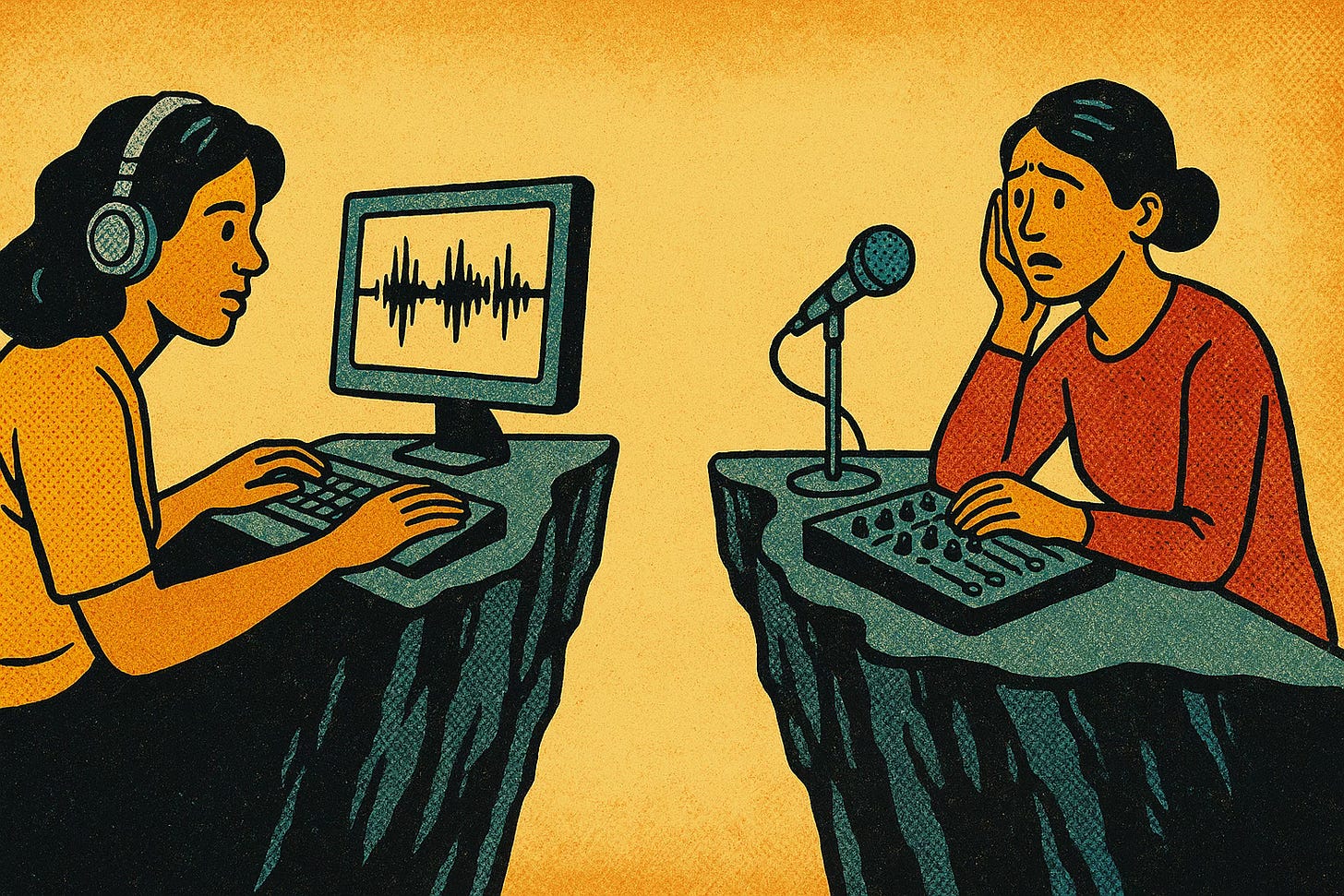Is remote work harming the audio industry?
The problem isn’t as much the remote work as the absence of in-person time. And I fear we’ll be feeling the effect for years.
Welcome to Dispatch #78 of The Audio Insurgent.
I must confess I was feeling a bit uninspired this morning, then I went through my backlog of mail (yes, actual letters and cards…it’s a thing with me), and opened this:
That’s pretty great–and a wonderful things to say (though I’ll admit I don’t feel that way all the time). So I decided to get over my laziness for this morning and write this dispatch, which has been gnawing at me for the past two weeks.
V.--the writer of the above card–is a supporter of The Audio Insurgent. She makes a small contribution to help offset the time it takes to write these and manage the work of the newsletter (which contains no actual news).
You can do that too! Just hit the subscribe button and pick the support level that matches the value of The Audio Insurgent–it is as little as $5. The button to smash is below.
And one of the perks of being a supporter is I will write a handwritten custom dispatch just for you! (And no fawning reply card is necessary–but deeply appreciated).
Onward…
[TODAY’S THING: IS REMOTE WORK HARMING THE AUDIO INDUSTRY?] I had come in to help some of our staff with a recording at Mag Noise and overheard the host and guest talking before the interview started. The guest, a professor of business and management, casually said, “I don’t know if I could prove this, but there seems to be some correlation between likelihood of burn out and remote work.”
That thought has rarely left my head in the weeks since–and has left me with a lot of thoughts about the price we pay for being a largely remote or hybrid industry.
I remember a time, not even a decade ago, when working from home was still a pretty foreign concept–and often felt like a mischievous and deviously delicious way to spend a day. Even though it was super healthy and productive, many turned up their nose at the idea.
Then COVID happened, blah, blah, blah.
But where are we now?
Very few audio shops are fully in-person. Most are hybrid or still entirely remote, and there is little indication that there is much interest in changing that. It does afford a lot of flexibility around work, work hours, and location. And come on, who needs to be in an office to stare at a Pro Tools session all day, right?
But I’ve also held the sometimes unpopular opinion that the audio industry pays a price for that lack of in-person time, on the individual level and also on the organizational and industry level. There is a slow creep of lack of connection, shallow relationship building, and a frustrated level of skill building. Its effect is subtle…like the frog in the pot of boiling water…so slow that we aren’t noticing how much it is contributing to the creative malaise that many are feeling in radio and podcasting right now.
And I say this is a “sometimes” unpopular opinion because when I bring this up, more than a few times I get a pretty hostile reaction.
So, let’s set some foundation here and discuss a few facts.
First, I’m not an oldie advocating for fully in-person work. I have always been an advocate for hybrid work–far before it was in vogue. In fact, during my years at Audible, I caught a lot of flack for "having my staff only work four days a week.” We never worked four-day weeks. However, from the start, we always worked remote or traveled for recording trips on Fridays whenever possible. This wasn’t really to give people more time off, but the opposite: try to coordinate time away and travel so more of us could be together more often in the office.
Also, there are a number of inconvenient truths that have emerged about remote creative work.
Let’s start with one of the most well-documented: creativity and collaboration suffer.
As happens a lot, a guest on one of our podcasts got me started thinking about this. Last year, we created a show for the Stanford Graduate School of Business called If/Then. In one episode, Jonathan Levav, a professor of marketing at Stanford, shared his study of remote work and creativity. “Pairs that worked face-to-face generated 15 to 20% more ideas than pairs that worked on Zoom,” he said. What’s more, in-person brainstorming helped people consider a wider and more diverse range of ideas. “Working on Zoom was a double penalty. Fewer ideas — and a narrower set of ideas.”
Further regarding collaboration, researchers from Microsoft published an article in Nature Human Behaviour analyzing anonymized data from over 60,000 Microsoft employees during the pandemic shift to remote work. What did they discover? That “Remote work caused the worker’s networks to become more static and siloed. People communicated more within their immediate teammates…and less with others in the organization. In short: remote work made it harder to discover ideas you didn’t already have.”
These aren’t isolated examples, either. A meta-analysis of over 60 academic studies published in Organizational Psychology Review found similar effects: remote work can impair creativity, limit informal learning, and reduce “ambient belonging”—the sense that you’re part of a larger creative mission.
There’s also compelling research from another Stanford professor, Nicholas Bloom, who has been studying remote work for over a decade. His early research (pre-COVID) found that remote workers were more productive—but only when the work was routine or individual in nature. For collaborative and creative work, the benefits were less clear—and more dependent on having regular in-person connection to sustain cohesion and trust.
What does that leave us with? It means the thing we often think of as “deep focus time” (i.e., working on tape, writing, DAW and Descript editing) does benefit from quiet, solo, and often remote work time. But the upstream and downstream parts—brainstorming, refining, editing with others, getting unstuck—are where the gaps start to show. So on the individual level: less connection to colleagues (and thus, less LEARNING from colleagues), crappier ideas, and perhaps even a higher propensity for burn-out.
Organizations should care—not just because it affects their people, but because it hurts the business too. Fewer and less compelling ideas are a big part of that, but also the lack of connection to other parts of the organization. The next Audio Insurgent will focus on the growing fissure between creatives and those on the business side of podcasting–and this Zoom-induced chasm is a substantial contributor to that. Sure, everyone avoids a commute and can work from their backyard on a beautiful day, but less compelling ideas create less compelling projects. Less collaboration and connection leads to the entire organization being less efficient and effective.
We’ve traded our commutes and shared kitchens for Slack threads and Zoom links, we may have inadvertently drained the informal connective tissue that holds great creative teams together. And I fear the effects of this will continue to grow with time. As someone who never attended a single journalism, media, or business course in college (okay, to be fair, I attended very few of any classes in college), I can attest that most people learn most things by being around other people doing that thing. They learn by seeing what to do, and what not to do, in real time and in person. They can ask questions. They can learn best practices. They can float their own ideas for real time advice, guidance, and feedback. It’s called growing…and that’s hard to do from the couch in your living room.
So, remote work is great…but also incredibly harmful…unless that harm is properly mitigated. And that’s the part I feel the audio industry is missing.
None of this is an argument for going back to five-day office life. It’s an argument for intentional thinking around time spent together. Most conversations on this start and stop on negotiating an organization’s remote work policy. But it is rare for any organization, of any size, to really talk about how to make the most of time spent together. At best, these discussions about mentoring, collaboration, coaching, and example-setting are treated as an afterthought.
So maybe the question isn’t “Remote or in-person?” Maybe it’s: “What are the moments that matter—and are we designing for them on purpose?”
Because if we want to keep growing—not just individually, but as organizations and as an industry—we’re going to need more than Slack threads and calendar links. We’re going to need real time with each other. And those who create that next great series—the one that makes you insanely jealous because you wish it came from your shop? It’ll come from a work culture that’s figured more of this out.
Okay, that’s it for today.
Thousands of people read this newsletter without even a free subscription. If this was forwarded to you or you read this online, would you mind subscribing?
If you are a regular reader of The Audio Insurgent, I hope you’ll consider doing your part by supporting this work with a small donation. And if that’s too much, you are also always welcome to buy my book or (even better) buy me a beer.
Make great things. I’ll be listening.
--Eric





